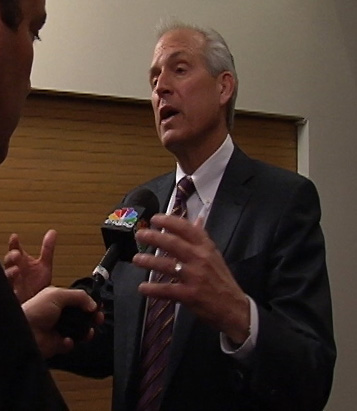
CEO Jim McNerney answers questions after Boeing Co.‘s 2013 annual shareholder meeting.
Ashley Lapin/MEDILL
(ARTICLE ORIGINALLY PUBLISHED MAY 15, 2013 ON MEDILL MONEY MAVENS)
Boeing Co.’s annual shareholder meeting at the Field Museum April 29 was a lively event. The James Simpson Theatre was packed with shareholders, some waiting to hear the latest updates on Boeing’s 787 Dreamliner troubles with overheating batteries.
CEO Jim McNerney, with interruptions from a few shareholder gadflies, apologized to shareholders for the incidents, which led the Federal Aviation Administration to ground the U.S. 787 fleet for three months, But the company made fixing the battery problem its top priority, he said, noting the FAA and its global counterparts had certified Boeing’s solution and approved the 787s to return to service the week prior.
“While we deeply regret the impact this issue had on our customers, we have learned from it and have made our airplanes even better,” said McNerney. “The promise of the 787 and game changing benefits it provides to customers and our passengers remains fully intact.”
On that positive note, McNerney also reported that Boeing had a strong 2012, with record revenues of $81.70 billion, 19 percent higher than 2011. He also mentioned a large backlog of orders, including 209 new orders booked in the first quarter of 2013 when earnings reached $3.90 billion.
McNerney also called a new Boeing airplane facility in Charleston, S.C., “a major milestone,” because it is the first commercial airplane factory built in the U.S. in more than four decades.
Of course, the commercial aviation business is only half of Boeing. The rest of the Chicago-based aerospace giant’s business comes from providing military aircraft and other equipment, a sector under pressure from budget cutting. “Despite a very difficult and uncertain business environment,” McNerney said that Boeing’s defense business had exceeded expectations in 2012. He added that he expects international sales to grow to be 30 percent of the company’s 2013 revenues.
Items on the meeting’s agenda included an advisory vote to approve the compensation packages of the company’s top executives. McNerney received almost $27.5 million in compensation for 2012, which was a 20 percent increase from 2011. His pay package was a beacon for criticism for a group of protesters who marched in front of Boeing’s headquarters on South Wacker Drive April 6.
The protesters, incensed by McNerney’s increased salary, rallied to decry Boeing’s plans to create a new combat drone. However, Boeing shareholders felt differently. They approved the compensation packages by a wide majority.
Shareholders voted against a shareholder proposal to require executives to retain significant amounts of company stock. They also voted against a proposal that would have required Boeing to have a chairman of the board who is separate from the CEO and president. The shareholder who submitted the proposal noted that McDonald’s Corp. does it that way and “if it’s good enough for McDonald’s, it should be good enough for the shareholders of Boeing.”
During the shareholders’ forum, various shareholders came forward to ask for everything from Boeing’s support in banning knives from airplanes to adding jobs in northern Wisconsin.
At a press conference following the meeting, McNerney expounded on the company’s outlook for a growing international clientele for defense products.
“I think Boeing has an unusually strong international operation because of the legacy of our commercial business,” said McNerney. “So when the two businesses get together outside the United States, I think we’re somewhat advantaged as we market our products, so I think we’re going to continue to gain share outside the United States.”
While McNerney was talking with reporters, Boeing shareholders had the option of a complimentary admission ticket to the Field Museum.





